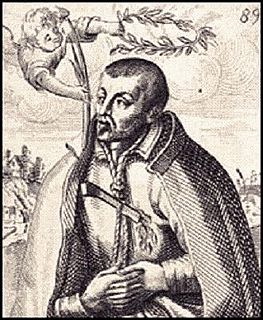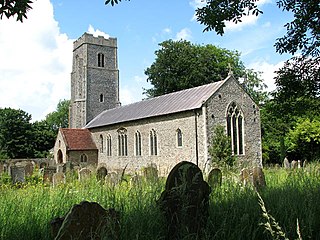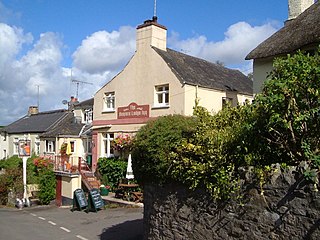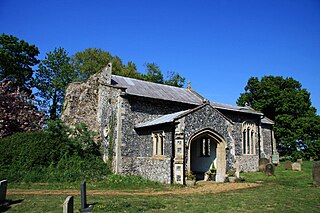Related Research Articles

Sheffield Manor Lodge, also known as Sheffield Manor or locally as Manor Castle, is a lodge built about 1516 in what then was a large deer park southeast of Sheffield, South Yorkshire, England, to provide a country retreat and further accommodate George Talbot, the 4th Earl of Shrewsbury, and his large family. The remnant of this estate is now known as Norfolk Park. The housing estate of Manor is named after Sheffield Manor Lodge.

Robert Southwell, also Saint Robert Southwell, was an English Roman Catholic priest of the Jesuit Order. He was also a poet, hymnodist, and clandestine missionary in post-Reformation England.
The Bishop of Southwell and Nottingham is the diocesan bishop of the Church of England Diocese of Southwell and Nottingham in the Province of York.

Swardeston is a village four miles (6 km) south of Norwich in Norfolk, England, on high ground above the Tas valley. It covers an area of 3.95 km2 (1.53 sq mi) and had a population of 619 at the 2011 census.

Southwell is a town in Nottinghamshire, England, the site of Southwell Minster, the cathedral of the Anglican Diocese of Southwell and Nottingham. A population of under 7,000 rose to 7,297 at the 2011 Census. The origin of the name is unclear. It lies on the River Greet, about 14 miles north-east of Nottingham. Other historic buildings include prebendal houses in Church Street and Westgate and the Methodist church, which has a right of way beneath it, so that the upper floor seats more than the lower. The workhouse (1824) was a prototype for many others. Owned by the National Trust, it shows its appearance in the 19th century. Behind the Minster is a partly ruined palace, once a residence of the Archbishop of York. It includes the recently restored State Chamber, Cardinal Wolsey's former dining room, and gardens among the ruins.
The Chief Butler of England is an office of Grand Sergeanty associated with the feudal Manor of Kenninghall in Norfolk. The office requires service to be provided to the Monarch at the Coronation, in this case the service of Pincera Regis, or Chief Butler at the Coronation banquet.

Sir Richard Southwell PC was an English Privy Councillor.

Norfolk County Cricket Club is one of twenty minor county cricket clubs within the domestic cricket structure of England and Wales. It represents the historic county of Norfolk.

Horsham St Faith is a village in Norfolk, England. The village lies close and to the east of the A140 road and is 5 miles (8.0 km) north of Norwich and some 8 miles (12.9 km) south of Aylsham It takes its name from the River Hor, which runs through it on its way from Horsford to Horstead; and a Benedictine priory, founded in honour of St. Faith that, until the dissolution of the monasteries, stood there. It is near Norwich International Airport, which began in 1939 as RAF Horsham St. Faith and home of the City of Norwich Aviation Museum. Administratively it is in the civil parish of Horsham St Faith and Newton St Faith within the district of Broadland.
This is a list of people who have served as Custos Rotulorum of Norfolk.

Horsham St Faith and Newton St Faith is a civil parish in the English county of Norfolk, consisting of the former parishes of Horsham St Faith and Newton St Faith. Collectively they are known as St Faiths. It covers an area of 7.33 km2 (2.83 sq mi) and had a population of 1,624 in 770 households at the 2001 census, increasing to a population of 1,724 in 797 households at the 2011 Census. For the purposes of local government, it falls within the district of Broadland.
Thomas Anthony Southwell, 3rd Viscount Southwell KP was an Irish peer. He became Viscount Southwell in 1796 on the death of Thomas Southwell, 2nd Viscount Southwell and was appointed a Knight of the Order of St Patrick on 12 September 1837. He was lord of the manor of Garway at Garway House in Herefordshire. The Irish peer married Jane, daughter of John Berkeley of Spetchley by Jane Compton. They became Roman Catholic and joint owners on their marriage of the several properties including Longmores, Lodge Farm, Church Farm and Coleman's Farm; and later New House Farm, Cwm Madoc Farm, Garway Court, Great Demesne Farm, and the Darren Mill on the River Monnow. The whole estate comprised almost 3,000 acres. The lordship included riparian rights to take profits from the river; with excellent salmon fishing in Victorian times, it was a lucrative tenure holding. In 1808 it was held jointly between Southwell and Robert Cannings Esq, who were also entitled to sit at the Court Baron, appoint the steward, and pass sentence on legal cases such as encroachment, amercements, obstruction and presentment; and the appointment of a petty constable to the parish. Lord Southwell appointed Thomas Wakerman of Graig, another Roman Catholic, in 1810 to be his manor steward. Wakerman was also a solicitor and eminent local historian. Lord Southwell only visited the county on a few occasions, to shoot pheasants. The rest of the time he spent in Ireland, London and the south of France. They had two sons and three daughters:

Robert Sackville, 2nd Earl of Dorset (1561–1609) was an English aristocrat and politician, with humanist and commercial interests.
Richard Southwell may refer to:

St Helen and St Giles is a church and landmark of Rainham and is the oldest building in the London Borough of Havering. The church retains many of its original features, for example the round-headed arches. It was founded by Richard de Lucy, the son-in-law of Henry II of England. de Lucy was also one of the instigators of the assassination of Thomas Becket, the Archbishop of Canterbury, in 1170. Construction of the church took place between 1160 and 1170. The church was restored during the period of 1893–1906, using donations from the Freemasons, yet it is still thought to closely resemble its original condition.

Cornworthy is a village and civil parish in the South Hams, Devon, England.
Sir Robert Southwell was an English civil servant during the reigns of Henry VIII, Edward VI and Mary I. He was elected Member of Parliament from Kent in October 1553 and in 1555. In January–February 1554 Southwell, then the High Sheriff of Kent, was one of the key loyalist officers engaged against the Wyatt's rebellion. According to D. M. Loades, "Sir Robert Southwell and Lord Abergavenny were almost the only significant gentlemen in the country whose loyalty was never in doubt. So resolute was Southwell's opposition to Wyatt that it is tempting to regard them as personal enemies, but .. there is no evidence for this."
Richard Southwell was a 15th-century British administrator from Norfolk.

Sir Robert Southwell (1563–1598), of Woodrising, Norfolk, was an English politician.

Woodrising is a village and former parish in Norfolk, England.
References
- ↑ "Norfolk Records". 1886.
- ↑ Starr, Brian Daniel (19 October 2010). Knighted Knowledge is Power. ISBN 9781462801381.